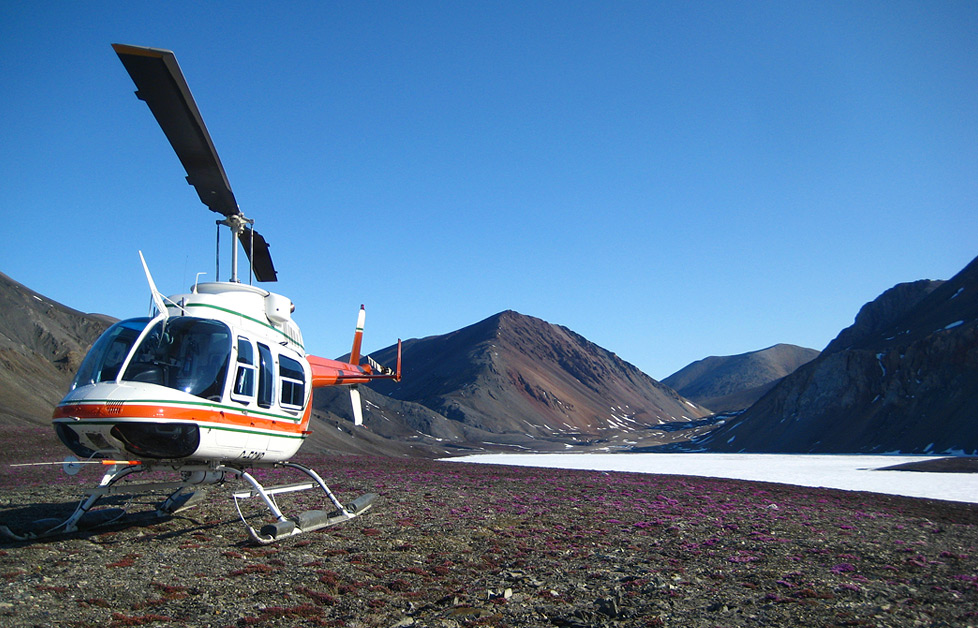Work Description
Field Work
Field work on snow and permafrost physical properties
There is currently very little data on how vegetation affects snow physical properties and one expected achievement of this project will be to obtain extensive data sets on snow density, thermal conductivity and albedo in different ecosystems, and of course to be able to model them. To complement these data sets, soil thermal conductivity, water content and hydraulic properties will be measured to capture all the variables required to model the permafrost thermal regime. The strategy will be to:
1. Deploy instruments at 4 subarctic and Arctic locations with representative ecosystems: taiga, forest-tundra, low shrub tundra and herb tundra. Three of these stations have already been partly deployed and funding is requested for optical instruments at each station and for a new station at the taiga location. The instruments are located at field stations of the CEN-UL: Kuujjuarapik (taiga, sporadic permafrost), Umiujaq (shrub and forest-tundra, discontinuous permafrost) and Bylot Island (herb tundra, thick continuous permafrost). See Figure.
2. Instruments include heated needle probes to measure the vertical profiles of snow and soil thermal conductivity [31], optical fibers to measure spectrally resolved light fluxes in snow (to be purchased), and all the aerial instruments required to calculate the energy budget of the surface. See Figure in appendix.
3. Perform winter and summer field campaigns to make point measurements of the vertical profiles of the above variables, to address spatial variability issues. Extra variables such as the hydraulic conductivity of soils, which cannot be measured automatically, will be measured during summer field campaigns.
4. Analyze data from the satellite SMAP instruments at 1.4 GHz [32] to determine soil freezing and test our simulations of soil freezing over Arctic and subarctic areas, in collaboration with A. Royer, U. Sherbrooke.
5. Make detailed identification of vegetation at all the sites studied for understanding of correlation between snow properties and vegetation type, in collaboration with E. Lévesque, U. Quebec at Trois-Rivières.

Locations of CEN stations (red dots). Work will be performed at Bylot Island (73°N, thick continuous permafrost, herb tundra), Umiujaq (56°N, discontinuous permafrost, shrub and forest-tundra) and Kuujjuarapik (55°N, sporadic permafrost, taiga).
Field work on OM fate in thawing permafrost
These field studies will be performed in collaboration with I. Laurion (INRS, Quebec City) for aquatic systems and N. Roulet (McGill, Montreal) for continental systems. Expected results include:

1. The measurement of CO2 and CH4 fluxes from thaw ponds and wetlands at Bylot Island and near Umiujaq.
2. The quantification of the release of OM from organic-rich permafrost to thaw ponds at these same sites.
3. The quantification of the extent of thaw ponds in the regions studied using high resolution satellite optical imagery (e.g. from the Geoeye or World-view satellites).
4. The continuation of time series of DOM content of thaw ponds to understand changes over time.
5. The investigation of relationships between OM inputs and GHG emissions for thaw ponds.
6. The understanding of the age-lability relationship of OM using carbon isotopes. The question here is how aging of OM affect its ability to be mineralized by microbes. Aging leads to chemical transformations that make OM more difficult to metabolize. Predicting GHG fluxes from available thawed OM is therefore difficult.
7. Measure all the components needed to construct the net ecosystem carbon balance (NECB) of wetlands.
Modeling Work
We will improve the simulation of snow and soil physical properties in the French LSMs ISBA (CNRM-GAME) and ORCHIDEE (LGGE) to produce models that perform well in arctic and subarctic environments. We will also improve the simulation of the carbon fluxes in high latitude soils to better predict the fate of OM and the emissions of GHGs. Expected achievements include:
1. The description of snow-vegetation interactions in the snow physics model Crocus, which is coupled to ISBA. Snow densification, erosion and deposition by wind, optical properties and thermal conductivity will be modeled based on the original data obtained in this project.
2. The description of thermal and hydraulic soil properties will be improved, notably by taking into account soil OM in both LSMs. In addition, aerobic and anaerobic decomposition processes of soil OM will be improved/added and an explicit vertical profile of soil OM will be properly simulated accounting for frozen vs. unfrozen part of the stock. All these processes will allow the LSMs to better simulate GHGs emissions.
3. The current representation of boreal vegetation and associated snow-vegetation interactions will be improved by introducing a more detailed description of high-latitude vegetation types, with advice from E. Levesque.
4. Work on permafrost erosion (through thermokarst etc.) and associated organic matter export will be undertaken.
5. Model runs will allow tests by comparison with field data. Point tests will be done for snow properties and for GHG emissions using data from experimental sites. Larger scale test will be done by forcing models with ERA40/interim reanalyses [33] and SMAP ground freezing data [32].
6. Finally, validated LSMs can be run coupled to the CNRM climate model [34] over the AMIP5 (Atmospheric Model Intercomparison Project) 1975-2008 period in order to assess the feedbacks between the climate and the physical surface processes of these regions.

